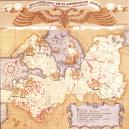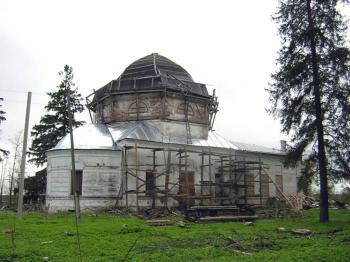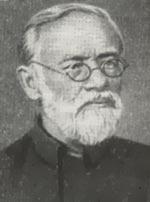Articles
/
The Culture of long burial mounds (barrows)
The Culture of long burial mounds (barrows)
Subject /
Relics
The Culture of long burial mounds (long barrows). The new culture was extended on the vast territory included Pskov Lake, the Velikaya, Lovat, Msta, Mologa and Chagodoshch (partly) rivers in the middle of AD 1000. This culture is distinguished by its burial mounds in the form of long barrows. Settlements constituted small unfortified settlements located not far from burial grounds. The Culture of long burial mounds was known in the Luga River uppersream basin and in the basin of the Chadogoshch River where burial grounds and long barrows and hills of the second half of AD 1000 were placed like strips in historical landscapes typical for them. The achaeological dig was carried out from the late 20th century (by A.A. Spitsin at the village of Zamosh'ye, by S.S. Gamchenko at the village of Sitenka). The systematical explorings were begun to carry out in the late 1920s by N.N. Chernyagin, G.P. Grozdilov, P.N. Shults. During the 1970-1990s the North-West expedition of the Leningrad State University has fulfilled exploring and the dig of burial mounds of the Long Barrow Culture in the Luga district (the village of Rapti-Navolok, the dig was fulfilled by G.S. Lebedev in 1971; the village of Estomichi, the dig was fulfilled by S.L. Kuzmin in 1995). Long barrows are not high artificial mound of the long from 10-12 m till 100 m located in the same burial grounds with round barrows of the hemispherical form. Every barrow includes several burial places, sometimes tens ones. After the cremation of the deads, remains of cremations were placed in differrent places of the barrow: in pits or on burial grounds in the barrow foundation, in burial urns, in birchbark pots, straight on the surface of the barrow. Not numerous finds (bronze "plaques-shells" and cap-shaped plaques, belt buckles, knives, small clay spinning wheels, blue glass-beads, fire stones, moulded clay vasas) allow to date the earliest burials as the 5th century and the lates as the 9-10th centuries when they were changed to the old Russian kurgan burials. Burials and settlements were usually located some distance away from edge of rivers and reservoirs on sand hills in dry pine forests, at roads. Population's activities basis was the complex forestry and slash agriculture with using the fire and hand farming implements. In the science literature long barrows were connected with both Slavs and pre-Slav population. The Idea about creating the Long Barrow Culture by the first wave of Slav settlers from the Middle Povislenye regions have become firmly established thanks to the works of the academician V.V. Sedov. The culture of long barrows included Balts which came together with the Slavs and the local Baltic-Finnish population.
Authors
Plotkin, Konstantin Moiseyevich
Persons
Chernyagin, Nikolay Nikolayevich
Gamchenko, Sergey Sviridovich
Grozdilov, Grigory Pavlovich
Kuzmin, Sergey Leonidovich
Lebedev, Gleb Sergeyevich
Schulz, Pavel Nikolayevich
Sedov, Valentin Vasilyevich
Spitsyn, Aleksandr Andreyevich
Geography
Topographical landmarks/Chagodoshcha River, the
Topographical landmarks/Cheremenetskoye Lake
Topographical landmarks/Lovat River, the
Topographical landmarks/Luga River, the
Topographical landmarks/Mologa River, the
Topographical landmarks/Msta River, the
Leningrad Oblast, the/Luga District/Navolok Village
Topographical landmarks/Pskovskoye Lake
Topographical landmarks/Sitenka Village
Topographical landmarks/Velikaya River, the
Leningrad Oblast, the/Luga District/Yestomchi Village
Leningrad Oblast, the/Luga District/Zamoshye Village (Relskaya Volost)
Bibliography
Лебедев Г.С. Длинные курганы Верхнего Полужья // Краткие сообщения Института археологии. 1974. № 139., С. 69-73
Лебедев Г. С. Археологические памятники Ленинградской области. Л., 1977, С. 78-99
Лесман Ю.М. Памятники культуры длинных курганов в Лужско-Оредежском междуречье// Новое в археологии Северо-Запада СССР. Л. 1985., С. 33-37
Седов В.В. Славяне в раннем Средневековье. М. 1995., С. 211-217
Спицын А.А. Раскопки 1910 г. в Лужском уезде С.-Петербургской губернии// Известия Археологической комиссии. Вып. 53. Пг. 1914., С. 89
Subject Index
Ancient settlements (selishche)
Old Russian Kurgans (barrows)
Mentioned in articles:
|
hidden
|
Ancient settlements (selishche)
Selishches, remains of unfortified settlements, discovering according to the presence of the culture lay and withdrawn material. The search of ancient settlements is embarrassed for lack of external indications. More then 120 ancient settlements... more
|
|
|
|
hidden
|
Archaeological monuments
Archaeological monuments of the Leningrad Oblast are settlements, grads, burial grounds, religious objects and other material trails of the past. Settling the oblast territory took place during the Mesolithic period. The age of the most ancient... more
|
|
|
|
hidden
|
Commission for the Archaeologic Research of the Leningrad Oblast
The Commission for the Archaeologic Research of the Leningrad Oblast. In 1919 the Russian Academy of the Material Culture History (RAIMK, later GAIMK) was esatblished in Petrograd. It was the predecessor of the conteporary centres of the Russian... more
|
|
|
hidden
|
Ozeryovo, village
OZERYOVO, a village in Boksitogorsk District. Located on the left bank of the Chagoda River that floods at that point forming a kind of lake (origin of the village’s name.) Population: 22. The Zabelino-Krasnaya Rechka motor road extends close to O.,... more
|
|
|
|
hidden
|
Spitsin, Aleksandr Andreyevich (1858-1931), a scientist
Spitsin, Aleksandr Andreyevich (1858-1931), an archaeologist, Corresponding Member of the Academy of Scienses (1927). He graduated from the St. Petersburg University in 1882. From 1892 Spitsin worked at the Archaeology Committee (the Committee was... more
|
|
|
|











